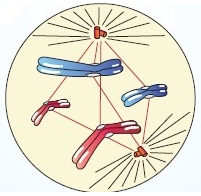CBSE Class 11 Biology – MCQ and Online Tests – Unit 10 – Cell Cycle and Cell Division
Every year CBSE schools conducts Annual Assessment exams for 6,7,8,9,11th standards. These exams are very competitive to all the students. So our website provides online tests for all the 6,7,8,9,11th standard’s subjects. These tests are also very effective and useful for those who preparing for any competitive exams like Olympiad etc. It can boost their preparation level and confidence level by attempting these chapter wise online tests.
These online tests are based on latest CBSE syllabus. While attempting these our students can identify the weak lessons and continuously practice those lessons for attaining high marks. It also helps to revise the NCERT textbooks thoroughly.
CBSE Class 11 Biology – MCQ and Online Tests – Unit 10 – Cell Cycle and Cell Division
Question 1.
How many chromosomes are there in onion root tip cell?
(a) 06
(b) 16
(c) 26
(d) 36
Answer
Answer: (b) 16
Explanation:
There are 16 chromosomes in onion root tip cell.
Question 2.
Lampbrush chromosomes are observed in
(a) Mitotic prophase
(b) Mitotic metaphase
(c) Meiotic metaphase
(d) Meiotic prophase
Answer
Answer: (d) Meiotic prophase
Question 3.
Choose the correct sequence. A. Pachytene B. Zygotene C. Leptotene D. Diakinesis E. Diplotene
(a) C, B, A, D, E
(b) C, A, B, E, D
(c) C, B, A, E, D
(d) D, B, C, E, A
Answer
Answer: (c) C, B, A, E, D
Explanation:
These are the five phases of prophase I of Meiosis I based on the chromosomal behaviour.
Question 4.
Choose the correct sequence. A. Chromatin condensation B. Protein synthesis C. Duplication of centrioles D. Centrioles moves towards opposite poles
(a) C, A, B, D
(b) C, B, A, D
(c) C, D, B, A
(d) A, C, D, B
Answer
Answer: (b) C, B, A, D
Explanation:
Duplication of centrioles occurs in S-phase.
Protein synthesis occurs in G2 phase.
Chromatin condensation is followed by centrioles movement towards the poles. (Prophase)
Question 5.
If you are provided with root-tips of onion in your class and are asked to count the chromosomes which of the following stages can you most conveniently look into:
(a) Prophase
(b) Anaphase
(c) Telophase
(d) Metaphase
Answer
Answer: (d) Metaphase
Question 6.
Karyokinesis is the term used for
(a) division of cytoplasm
(b) division of nucleoplasm
(c) division of nucleus
(d) separation of daughter chromosomes
Answer
Answer: (d) separation of daughter chromosomes
Explanation:
Karyokinesis means separation of daughter chromosomes.
Cytokinesis means division of cytoplasm.
Question 7.
During which stage the chromosomes first become visible.
(a) Anaphase
(b) Metaphase
(c) Prophase
(d) Telophase
Answer
Answer: (c) Prophase
Question 8.
In mitosis, nuclear envelope and nucleolus disappear during
(a) Metaphase
(b) Interphase
(c) Prophase
(d) Telophase
Answer
Answer: (c) Prophase
Question 9.
Arrange the following events of meiosis in the correct sequence: I. Terminalization II. Crossing over III. Synapsis IV. Disjunction of genomes The correct sequences:
(a) II, I, IV, III
(b) III, II, I, IV
(c) IV, III, II, I
(d) I, IV, III, II
Answer
Answer: (b) III, II, I, IV
Question 10.
The major event that occurs during the anaphase of mitosis, which brings about the equal distribution of chromosomes, is
(a) splitting of the centromeres
(b) splitting of the chromatids
(c) replication of the genetic material
(d) condensation of the chromatin
Answer
Answer: (a) splitting of the centromeres
Question 11.
What type of plant is formed when colchicine is used in the process of development of Raphanobrassica?
(a) Autotetraploid
(b) Haploid
(c) Triploid
(d) Allotetraploid
Answer
Answer: (d) Allotetraploid
Question 12.
Meiosis occurs for the human female in ______.
(a) Pancreas
(b) Liver
(c) Ovary
(d) Kidney
Answer
Answer: (c) Ovary
Question 13.
The stage in which daughter chromosomes move toward the poles of the spindle is
(a) Anaphase
(b) Metaphase
(c) Prophase
(d) Telophase
Answer
Answer: (a) Anaphase
Question 14.
Synaptonemal complex dissolves in _____ stage.
(a) Zygotene
(b) Pachytene
(c) Diakinesis
(d) Diplotene
Answer
Answer: (d) Diplotene
Explanation:
Synaptonemal complex dissolves in diplotene stage of Prophase I.
Question 15.
Golgi complex and endoplasmic reticulum cannot be seen during
(a) late telophase
(b) late prophase
(c) early anaphase
(d) late metaphase
Answer
Answer: (b) late prophase
Explanation:
Cells, when viewed under microscope at the end of prophase, do not show golgi complex, endoplasmic reticulum, nucleolus and nuclear envelope.
Question 16.
Cell plate grows from
(a) walls to the centre
(b) centre to the walls
(c) in patches
(d) simultaneously
Answer
Answer: (b) centre to the walls
Explanation:
Cell plate grows during cytokinesis from centre to the walls.
Question 17.
Which of the following cellular structures always disappears during mitosis and meiosis?
(a) Plasma membrane
(b) Nucleolus and nuclear envelope
(c) Plastids
(d) none of these
Answer
Answer: (b) Nucleolus and nuclear envelope
Question 18.
Centromere is a constituent of
(a) Ribosome
(b) ER
(c) Chromosome
(d) Mitochondrion
Answer
Answer: (c) Chromosome
Question 19.
In which phase of cell cycle, proteins are synthesised?
(a) G0
(b) G1
(c) G2
(d) S
Answer
Answer: (c) G2
Explanation:
In G2 phase of cell cycle, proteins are synthesised for mitosis and cell growth continues.
Question 20.
Which phase of cell cycle is shown in the above picture?
(a) Early prophase
(b) Early metaphase
(c) Early telophase
(d) Early anaphase
Answer
Answer: (b) Early metaphase
Explanation:
Chromosomes are positioning towards the equator.
Nuclear envelope is disintegrated.














0 Comments:
Post a Comment